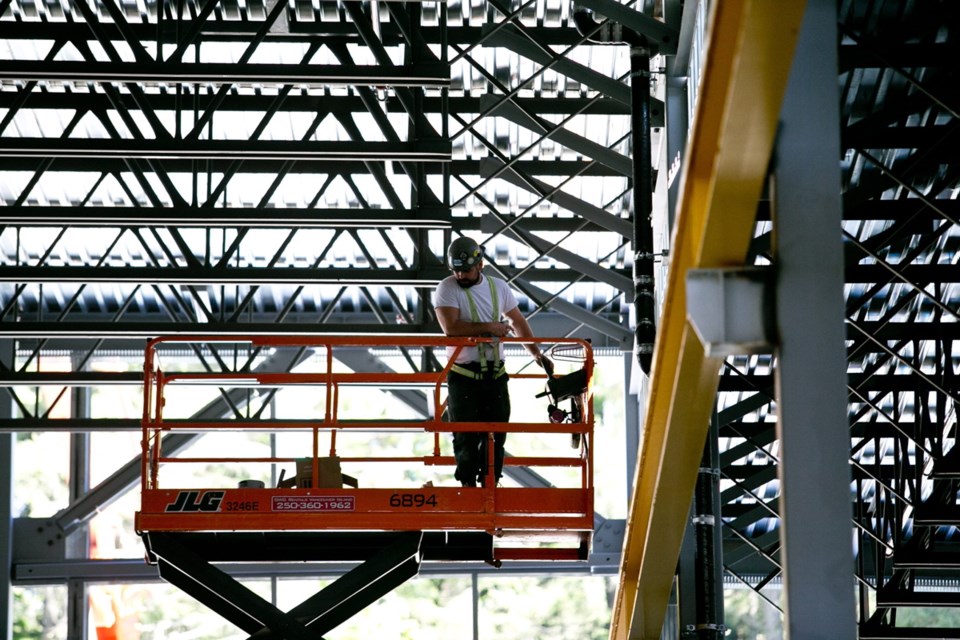The $30-million Centre for Trades Education and Innovation at Camosun College is starting to take shape, but the chevron-shaped building is only one piece of a complex puzzle the school has undertaken to improve trades training delivery.
The 80,000-square-foot space will open in September and house automotive, heavy duty commercial transport, marine technology, sheet metal, welding and metal fabrication courses. It marks the start of a number of moves that will completely change trades training at the Interurban campus.
“There will be a bit of a ripple effect,” said Al van Akker, chairman of architectural trades at Camosun. “[The new building] gives us modern space. The buildings we are using now were built in the early 1970s. And since then the trades have evolved significantly, the programs have grown.”
Van Akker said the new building space will free up a lot of square footage in the Jack White and John Drysdale buildings, which currently house the bulk of trades training, and will mean some programs will be on the move.
Currently, electrical is split in a number of locations, but will be consolidated in the White building, which will also contain fine furniture and joinery.
Advanced manufacturing will also move to that location.
The Drysdale building will then house carpentry and pipe trades, giving all programs more space and more capacity for new students.
“There’s been pressure to add more training sections and we have been tightly squeezed and having to run multiple cohorts at different times of the day to accommodate demand,” said van Akker.
But significant expansion of the student body will have to wait until the existing buildings undergo renovations to modernize them and establish more space.
“There’s going to be a bit of a shuffle done,” said Angus Matthews, campaign director for the TRADEmark of Excellence campaign, Camosun’s capital fundraising arm.
TRADEmark has initiated a campaign intent on raising $5 million to both add new equipment for the new building and renovate and update the existing trades buildings. A significant announcement about the fundraising goal is expected next week.
“Camosun said we can make [the new building] exceptional by supplementing the government funding in order to renovate the old buildings,” he said. “So we will end up with 80,000 square feet of new space and 180,000 square feet of renovated space.”
Matthews said the updating program will take between 18 and 24 months. When complete, it should allow the school, which currently trains 2,700 trades students each year, to handle another 1,000 students. “We already have wait-lists and we are trying to shorten those, but we couldn’t take more students until we had more space,” he said.
The new building, being built to a LEED Gold environmental standard, will help trim those numbers. It’s also unlike the kinds of buildings people tend to associate with trades training. The main entrance, whose shape resembles that of a ship’s prow and keel, opens into a 4,400 square foot, bright glass atrium designed to be welcoming to students and offer a place to relax and for collaborative thought.
The building will make use of natural light wherever possible, using translucent panels in walls and glass panels on rolling doors.
Most of the labs and shops are on the main floor, and there is a mezzanine.
The automotive shop is 10,000 square feet and includes in-ground service bays and space for extensive diagnostic equipment. The heavy duty mechanical shop is 6,300 square feet and welding and fabrication takes up a 13,000-square-foot space with 60 welding booths.
The sheet-metal shop takes up 7,300 square feet, marine technology has a 2,700-square-foot lab and the nautical simulation lab, which allows students to experience a variety of digitally-generated ship movement situations, is 1,000 square feet. There are also a string of labs and classrooms ranging in size from 765 to 1,000 square feet.
“This building and the renovations really help position Camosun as a trades powerhouse,” said Matthews.
Van Akker said it is about “right-sizing” the school and giving students appropriate space to learn.



